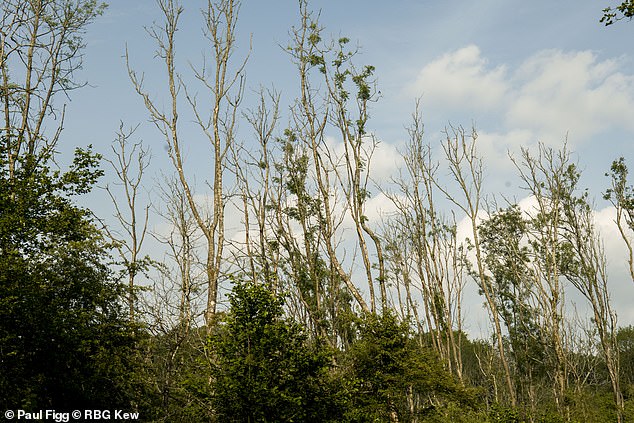[ad_1]
Britain’s trees are evolving resistance to the deadly ash dieback fungus, scientists have revealed.
The disease, which arrived in Britain in 2012, has wrought havoc on the countryside, leaving behind the skeletal remains of dying ash trees.
Previous estimates predict that up to 85 per cent of ash trees will succumb to the disease, and COBRA have held emergency meetings about how to deal with the issue.
But now, experts have discovered that a new generation of ash trees, growing naturally in woodland, exhibit greater resistance to the disease compared to older trees.
They found that natural selection is acting upon thousands of locations within ash tree DNA, driving the evolution of resistance.
The study provides a real-world example of natural selection in action, they said.
And it offers renewed hope for the future of ash trees in Britain.
‘Thanks to natural selection, future generations of ash should have a better chance of withstanding infection,’ Dr Carey Metheringham, from Queen Mary University of London (QMUL) said.

The new study, published in the journal Science, focused on Marden Park wood in Surrey, a semi-natural ancient woodland dominated by ash. Pictured: Ash dieback in the area

Hope for the future: Experts have discovered that a new generation of ash trees exhibit greater resistance to the disease compared to older trees

Ash dieback, which arrived in Britain in 2012, has wrought havoc on the countryside, leaving behind skeletal remains of dying ash trees. Pictured: The effects of the disease in the Hughenden Estate, Buckinghamshire
Ash dieback is caused by the fungus Hymenoscyphus fraxineus, which originated in Asia.
The new study, published in the journal Science, focused on Marden Park wood in Surrey, a semi-natural ancient woodland dominated by ash.
Researchers compared the DNA of ash trees established before and after the fungal invasion reached Britain.
They found shifts in variants associated with tree health in thousands of places across the overall genome of the trees.
The findings indicate younger generations of trees have greater resistance to the fungus, they said.
And it could mean ash does not go the same way as elm trees, which have been largely lost from the British landscape as a result of Dutch elm disease, although breeding programmes may be needed to bolster the fightback.
‘Natural selection alone may not be enough to produce fully resistant trees,’ Dr Metheringham added.
‘The existing genetic variation in the ash population may be too low, and as the trees become scarcer, the rate of selection could slow.

Drone footage taken by the National Trust has revealed the extent of the devastation being wrought on British woodlands by ash dieback. Pictured: infected and dead ash trees can be seen among their healthy counterparts in the Hughenden Estate in Buckinghamshire

Ash dieback has accelerated across the country this and its impact is clearly visible in these woodlands on the National Trust’s Hughenden Estate

Ash dieback is caused by the fungus Hymenoscyphus fraxineus, which originated in Asia. Pictured: A closed path in Marden Park
‘Human intervention, such as selective breeding and the protection of young trees from deer grazing, may be required to accelerate evolutionary change.’
Another of the study’s authors, Professor Richard Buggs, from the Royal Botanic Gardens at Kew and Queen Mary, said: ‘We are so glad that these findings suggest that ash will not go the way of the elm in Britain.
‘Elm trees have struggled to evolve to Dutch elm disease, but ash are showing a very different dynamic because they produce an abundance of seedlings upon which natural selection can act when they are still young.
‘Through the death of millions of ash trees, a more resistant population of ash is appearing.’
Rebecca Gosling, from the Woodland Trust which owns and manages Marden Park wood, said: ‘Ash dieback demonstrates how devastating introduced pathogens can be for our trees and the species which rely upon them.
‘This important research gives us hope for the future of our ash populations.’
She added: ‘The findings highlight how vital it is to support natural regeneration in woodlands, furthering our understanding of how to best manage our ash woodlands.’
The study was mainly funded by the Environment Department (Defra) whose chief plant health officer Professor Nicola Spence said it demonstrated that tolerance to ash dieback can be inherited, and breeding programmes and natural regeneration together could secure the future of native ash.
Previously, the Woodland Trust has estimated that more than 100 million ash trees are expected to be lost to ash dieback, at a cost of over £15 billion.
The disease blocks water systems and causes leaves to wilt, shoots to die, lesions on branches and eventually the death of the tree.
Last year, scientists announced they were working on gene-edited saplings that are immune to ash dieback.
And since the initial crisis more than a decade ago, there has been a nationwide overhaul of how the government approaches plant diseases.
[ad_2]
This article was originally published by a www.dailymail.co.uk . Read the Original article here. .

